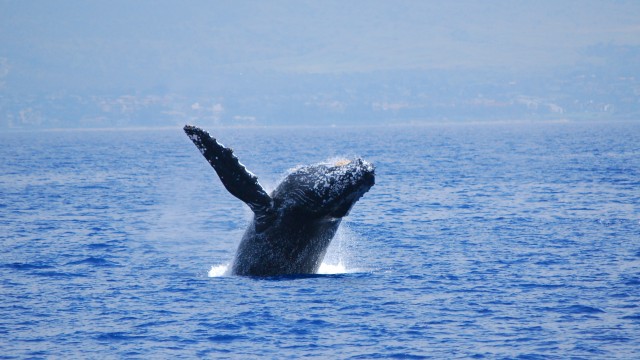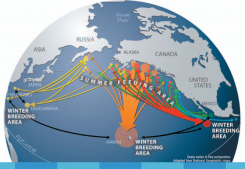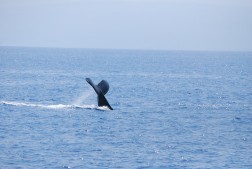
Look at a globe or photo of Earth from space and you can see our blue planet, with the continents surrounded by ever-circulating, briny waters of the sea. Perhaps no living thing has a better appreciation of the continuity of the seas than the largest animals in them: whales. From continent to continent, they travel between warm waters for birthing their young, then saunter endless miles to frigid polar seas that teem with arthropods and fish. Whales are one of our most amazing co-inhabitants of the planet.
Directly off our coast every spring, gray whales parade past our shores in the longest migration of any mammal, about 10,000 miles round trip. Sometimes we can see them even closer to home when they occasionally enter the Bay, as a cow-calf pair did recently. For several years the grays seemed to be making more stops in the Bay, with fewer sightings in the last few years. The Oceanic Society collected data on them including what they were doing here (feeding, resting, or perhaps getting lost) and how toxins in Bay mud may affect them. They're planning to reinstate their data collection this year and next with the increase of whale visits in the Bay. (See their report at the Oceanic Society website).

Gray whales have made an amazing comeback from the brink of extinction. With international and federal government protection, their population has returned to levels estimated for their pre-hunting numbers. There are many opportunities between now and mid-April to view the gray whale migration for yourself either from a boat or from shore. For great views from shore, check out the Point Reyes National Seashore and other Bay Area shorelines. I had an exciting view of a young gray whale breaching, launching itself out of the water repeatedly, from the Point Reyes lighthouse in early April one year. It really made the climb down and back up those 300 steps worthwhile!
Humpback whales are another species that traverse the vast Pacific, though in much smaller numbers than the gray whales. Humpbacks are an endangered species with both international and federal government protected status. Their population was monitored and mapped in the north Pacific. The study, conducted for four years, found a much more complex population movement and dispersion than scientists had expected. The Hawaiian Islands are largest calving grounds with the shallower seas around Maui designated as the Humpback Whale Sanctuary. You can watch humpback cows teaching their calves the finer points of breaching, fin and tail slapping, and hear male humpbacks singing underwater. Listen to a humpback whale song from the NOAA website.

Food for thought: the majority of humpbacks swim through the Pacific Gyre, an island of floating trash, mostly plastics, trapped by ocean currents and estimated to be the size of Texas. Akin to pushing a baby stroller through a garbage dump, swimming through this area could expose young humpbacks to toxins accumulating in the small plastic pellets - DDT, PCBs, and the like. Some steps we can take closer to home that'll help our ocean wildlife is to reduce the amount of plastics we use. Check out this blogger's account about going 30 days without using plastics and consider where you can cut down on the amount of single-use plastics in your life: Modern Muse: 30 Days without Plastic The whales and ocean wildlife will be better off for it, and so will we!
